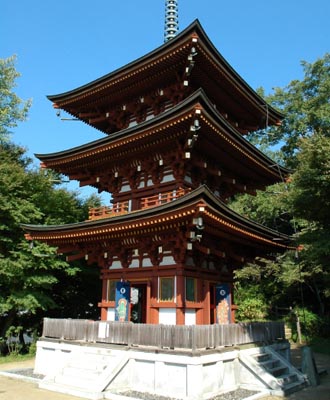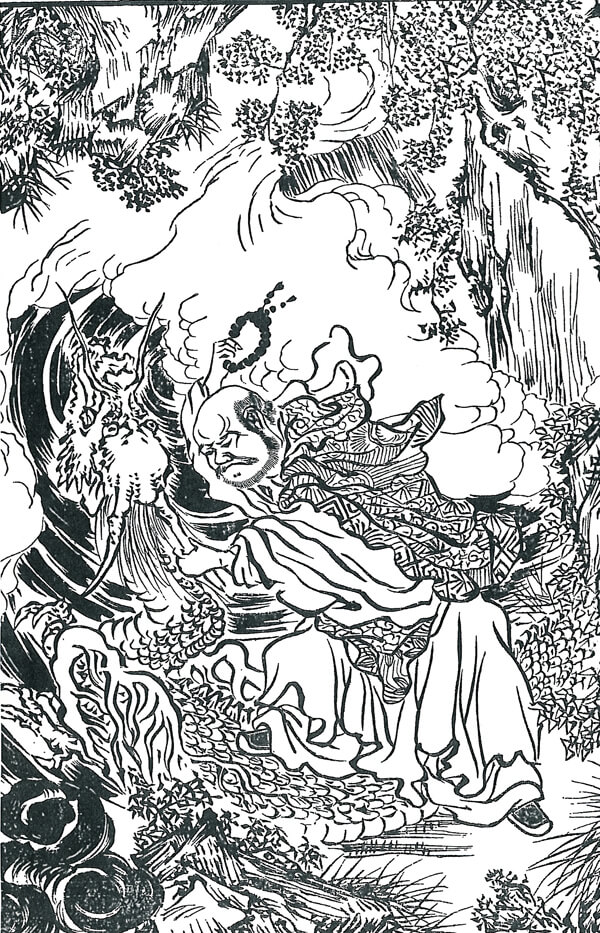
Okadera (岡寺) – Ryūgaiji, Temple of the Dragon Lid
Okadera, formally known as Tōkōzan Shinjūin Ryūgaiji, is a Shingon Buzan sect temple set on the slopes east of Asuka, Japan’s first capital. Established by the ascetic priest Gien Sōjō in the 7th century under the patronage of Emperor Tenchi, it is venerated as Japan’s first temple for protection against misfortune (yakuyoke). The temple’s popular name, “Okadera,” comes from its location in the hills of Asuka, while its formal name, “Ryūgaiji,” recalls the legend of a dragon subdued and sealed beneath a pond here.
Things to See at Okadera
Niōmon
The main gate, built in 1612 and designated a National Important Cultural Property, is flanked by guardian Niō statues. Restoration in 1963 revealed that some wooden parts predated the gate’s construction.
Celestial Animals
Carvings of lion-dogs, a tiger, and a dragon adorn the gate’s corners, serving as structural and symbolic protectors.
Bell Tower and Yakudoshi
The shōrō, built alongside the Hondō in 1805, houses a bell that visitors may ring. A sign in front lists the inauspicious ages (yakudoshi) when people often visit Okadera for protective amulets.
Kaisandō
The Founder’s Hall roof was restored between 1999 and 2008 to its original cypress bark style. An inscription on a gargoyle dates to 1797, though the structure is likely older.
Hondō
Dating from the early 19th century, the Hondō enshrines the temple’s massive clay Nyoirin Kannon and houses treasures including a replica of the Tennin Monsen tile, a National Treasure.
Ryūgai Pond
This sacred pond holds the “Aji Ishi” stone lid that seals the dragon subdued by Gien Sōjō. Tradition says lifting the lid during drought summons rain.
Inari Shrine
Enshrines the guardian fox deity of the temple.

Okunoin Sekkutsu
A natural cave, unique among pilgrimage temples, serving as the temple’s inner sanctuary and symbolizing the womb. Miroku Buddha is enshrined here.
Sanjūhōtō
A three-tiered pagoda built in 1472 after a typhoon destroyed its predecessor, renovated in 1986 with an intricate painted mandala inside.

Stone Images
Small, weathered Buddhist carvings are scattered throughout the grounds and surrounding mountains, adding to Asuka’s mystical atmosphere.
Legends of Okadera
The Dragon Lid
A destructive dragon once plagued the Asuka region with floods. Gien Sōjō prayed to Kannon, who helped him tame the dragon. He sealed it in a pond beneath the sacred “Aji Ishi” stone marked with the Sanskrit letter “A.” This act gave the temple its name, “Ryūgaiji” (Dragon Lid Temple), and established its role as a protector against calamity.

Principal Image of Worship
The nearly 5-meter-tall clay Nyoirin Kannon, Japan’s largest clay image, is said to have been created from clay gathered in India, China, and Japan. Attributed by legend to Kōbō Daishi, the statue’s form derives from a small “fingernail” carving he made during a storm at sea, when Nyoirin Kannon appeared to save his ship. Though only the head and hands remain from the original, the statue is revered as a guardian against disaster.
Goeika of Okadera
Kesa mireba
Tsuyu Okadera no
Niwa no koke
Sanagara ruri no
Hikari narikeri
In the morning when I see
The dew on the moss
In the garden of Okadera
It looks just like lapis
Shining brightly


